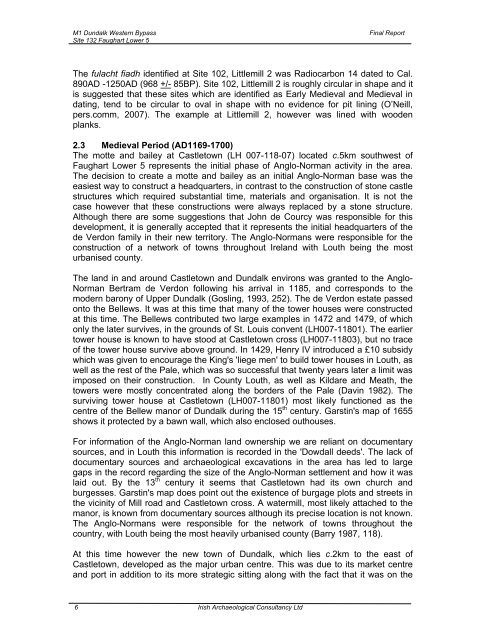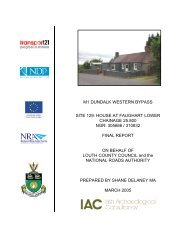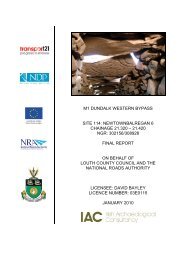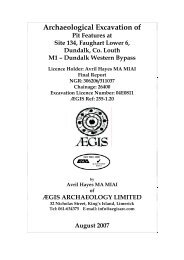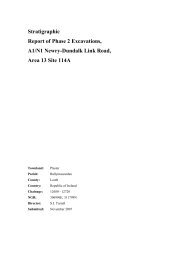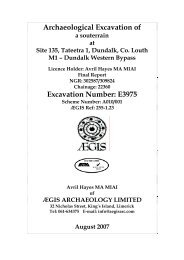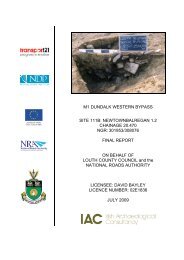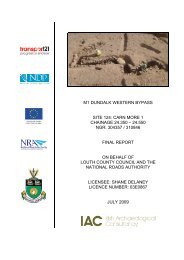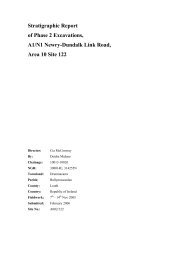Faughart Lower 5 Final Report - ASI Louth
Faughart Lower 5 Final Report - ASI Louth
Faughart Lower 5 Final Report - ASI Louth
You also want an ePaper? Increase the reach of your titles
YUMPU automatically turns print PDFs into web optimized ePapers that Google loves.
M1 Dundalk Western Bypass<br />
Site 132 <strong>Faughart</strong> <strong>Lower</strong> 5<br />
<strong>Final</strong> <strong>Report</strong><br />
The fulacht fiadh identified at Site 102, Littlemill 2 was Radiocarbon 14 dated to Cal.<br />
890AD -1250AD (968 +/- 85BP). Site 102, Littlemill 2 is roughly circular in shape and it<br />
is suggested that these sites which are identified as Early Medieval and Medieval in<br />
dating, tend to be circular to oval in shape with no evidence for pit lining (O’Neill,<br />
pers.comm, 2007). The example at Littlemill 2, however was lined with wooden<br />
planks.<br />
2.3 Medieval Period (AD1169-1700)<br />
The motte and bailey at Castletown (LH 007-118-07) located c.5km southwest of<br />
<strong>Faughart</strong> <strong>Lower</strong> 5 represents the initial phase of Anglo-Norman activity in the area.<br />
The decision to create a motte and bailey as an initial Anglo-Norman base was the<br />
easiest way to construct a headquarters, in contrast to the construction of stone castle<br />
structures which required substantial time, materials and organisation. It is not the<br />
case however that these constructions were always replaced by a stone structure.<br />
Although there are some suggestions that John de Courcy was responsible for this<br />
development, it is generally accepted that it represents the initial headquarters of the<br />
de Verdon family in their new territory. The Anglo-Normans were responsible for the<br />
construction of a network of towns throughout Ireland with <strong>Louth</strong> being the most<br />
urbanised county.<br />
The land in and around Castletown and Dundalk environs was granted to the Anglo-<br />
Norman Bertram de Verdon following his arrival in 1185, and corresponds to the<br />
modern barony of Upper Dundalk (Gosling, 1993, 252). The de Verdon estate passed<br />
onto the Bellews. It was at this time that many of the tower houses were constructed<br />
at this time. The Bellews contributed two large examples in 1472 and 1479, of which<br />
only the later survives, in the grounds of St. Louis convent (LH007-11801). The earlier<br />
tower house is known to have stood at Castletown cross (LH007-11803), but no trace<br />
of the tower house survive above ground. In 1429, Henry IV introduced a £10 subsidy<br />
which was given to encourage the King's 'liege men' to build tower houses in <strong>Louth</strong>, as<br />
well as the rest of the Pale, which was so successful that twenty years later a limit was<br />
imposed on their construction. In County <strong>Louth</strong>, as well as Kildare and Meath, the<br />
towers were mostly concentrated along the borders of the Pale (Davin 1982). The<br />
surviving tower house at Castletown (LH007-11801) most likely functioned as the<br />
centre of the Bellew manor of Dundalk during the 15 th century. Garstin's map of 1655<br />
shows it protected by a bawn wall, which also enclosed outhouses.<br />
For information of the Anglo-Norman land ownership we are reliant on documentary<br />
sources, and in <strong>Louth</strong> this information is recorded in the 'Dowdall deeds'. The lack of<br />
documentary sources and archaeological excavations in the area has led to large<br />
gaps in the record regarding the size of the Anglo-Norman settlement and how it was<br />
laid out. By the 13 th century it seems that Castletown had its own church and<br />
burgesses. Garstin's map does point out the existence of burgage plots and streets in<br />
the vicinity of Mill road and Castletown cross. A watermill, most likely attached to the<br />
manor, is known from documentary sources although its precise location is not known.<br />
The Anglo-Normans were responsible for the network of towns throughout the<br />
country, with <strong>Louth</strong> being the most heavily urbanised county (Barry 1987, 118).<br />
At this time however the new town of Dundalk, which lies c.2km to the east of<br />
Castletown, developed as the major urban centre. This was due to its market centre<br />
and port in addition to its more strategic sitting along with the fact that it was on the<br />
6<br />
Irish Archaeological Consultancy Ltd


